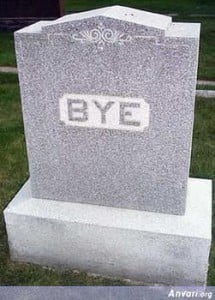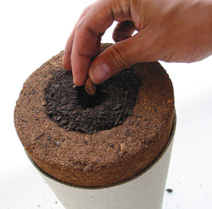
One of these days, I will shuffle off this mortal coil, vacate the earthly tent (as Paul put it), slip beyond the veil, or any of the myriad other metaphors for death.
As a preacher’s kid, I had to attend funerals. A lot of them. I grew to hate the traditional bit of pumping a corpse full of preservatives, putting the deceased into a suit he never wore in real life, and then locking them into an air-tight, metal coffin and a concrete vault before burial under a ton of dirt.
Even as a kid, it all struck me as madness left over from the stone age, when people, wondering what to do with the person who stopped breathing and started to stink, decided to dig a hole, toss them in and — to somehow make the process something more than just taking out the garbage, I guess — planted the loved one with his favorite spear, or her pottery, baskets, etc.
The funeral rites got a lot more complicated after that, of course. But basically, 100,000 years later, we are doing the same thing.
We seem to have a death dichotomy: we agree our bodies should return to the earth, but then we slow down the process as much as we can, and drive our loved ones into debt to do it. Meanwhile, some funeral directors alternately sympathetically coo and cajole the grieving into more elaborate, and pricey options for disposing of the dead.
Respect for the dead. If you really loved him or her, you’d choose burial over cremation, and upgrade from the pine box to that casket made of space-age metals that not only will stave off decomposition beyond your own lifetime, but survive an annihilation-scale meteor strike of Earth. Good grief. That dead flesh and bone is not a holy relic (if there truly are such things); those remains are not a fragment of the “true cross” or the toe nails of Our Lady of Perpetual Motion on that mortuary slab.
They’re remains. As in, what was left behind after the spirit, the person is gone. As Solomon once wrote in Ecclesiastes 12:7 (NIV): “. . . And the dust returns to the ground it came from, and the spirit returns to God who gave it.”
There have been exceptions, of course. Zoroastrians exposed their dead to the elements, a rather “green” (if messy) alternative. Many other cultures liked funeral pyres, the imagery of their honored dead drifting into the night sky as cinders somehow heroic and comforting.

You can probably see where I’m going with this. Like my paternal grandparents before me, I prefer cremation. Oh, I know there will be no legendary sendoff with a 10-foot-high stack of wood, or a fiery final voyage on a Viking long ship . . . but the idea of reducing my decomposing remains to ashes just seems right. (To me; not everyone. It’s a choice, and I, for one, do not see tradition and the Word of God as the same thing).
But what to do with the ashes? A mausoleum niche doesn’t appeal to me, after some years ago I visited my grandparents in what turned out to be an abandoned structure with a partially collapsed roof, awash with rain water and dust.
I guess a post hole grave for the ashes would be OK. Or poetically specifying divvying up the ashes between my survivors to plant, scatter or turn into a cremains sculpture, as they wish.
But now, I think I have found the perfect solution. I like the idea because it makes that circle the Bible speaks of: “. . . for dust thou art, and unto dust shalt thou return” (Genesis 3:19 KJV).
Back to the soil, to nurture new life. Beats being interred, a slowly rotting corpse in a sort of “deathy” bomb shelter; or in an urn, collecting dust.
So, I could be especially inconsiderate of my kids, I suppose, and give them detailed instructions: (1) Take ashes, (2) put in bucket, (3) mix in equal amount of manure (their choice, but not human), (4) mix well, (5) dig hole, (6) dump the “Bob potting soil” into hole, (7) add handful of tree seeds and cover, and (8) occasionally water.
Oh. And if it’s an apple tree that grows, make a pie. Or not.

Seriously, though, I have found a possible best-practices sort of cremation resolution in the Bios Urn. I love this. It’s no fuss, little muss, biodegradable (as we all will be, sooner or later), and turns your loved one, eventually, into a tree. Or a bush. Maybe even a pumpkin; depends on the seeds you use, I guess.
Make mine a tree, though. I’ve always loved trees.

